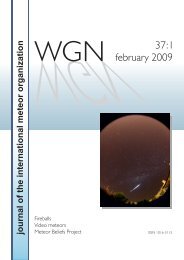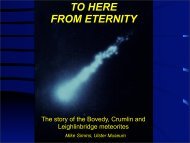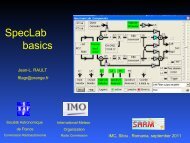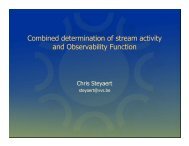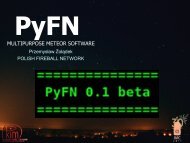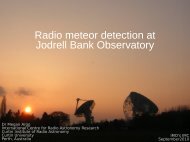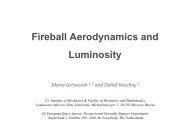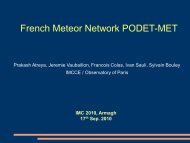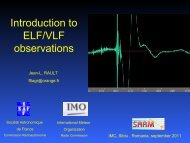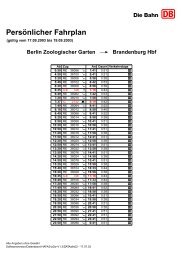Untitled - International Meteor Organization
Untitled - International Meteor Organization
Untitled - International Meteor Organization
Create successful ePaper yourself
Turn your PDF publications into a flip-book with our unique Google optimized e-Paper software.
WGN, the Journal of the IMO 38:5 (2010) 161<br />
<strong>Meteor</strong> activity from the Perseus-Auriga region in September and<br />
October<br />
Jürgen Rendtel 1 and Sirko Molau 2<br />
A systematic search was carried out for radiants of high-inclination meteor showers in September and October<br />
based on data collected over eleven years with cameras of the IMO Video <strong>Meteor</strong> Network. The Aurigids<br />
(206 AUR), with an outburst in 2007, and the September ε-Perseids (208 SPE), with an outburst in 2008, were<br />
the most prominent showers. Detailed SPE outburst data of 2008 are presented. Data of the October Lyncids<br />
(228 OLY) and the β-Aurigids (210 BAU) stored in the database of the IAU <strong>Meteor</strong> Data Center have been<br />
confirmed. Radiant data of the September Lyncids (81 SLY) have been improved, and the activity period of the<br />
δ-Aurigids (224 DAU) has been better defined. Two new radiants have been detected: the September-October<br />
Lyncids (424 SOL) and the ψ-Aurigids (425 PSA). All showers are at high-inclination orbits and may be part of<br />
a complex which could be similar to the Kreutz group of comets.<br />
Received 2010 August 20<br />
1 Introduction<br />
In the detailed analysis of video meteor data published<br />
in August 2009 (Molau & Rendtel, 2009) the radiants<br />
in the Perseus-Auriga region in September and October<br />
were excluded because of their complex appearance.<br />
In that paper we described the most prominent showers<br />
from this region, the Aurigids (206 AUR) and the<br />
September ε-Perseids (208 SPE). Further, the September<br />
Lyncids (81 SLY) were associated with one of the<br />
radiants found active for only three data bins.<br />
The case of these high-inclination showers was also<br />
selected for a separate paper because of the probable<br />
existence of more than two showers in that region and<br />
in the specified period. <strong>Meteor</strong> activity from that region<br />
has been the subject of earlier analyses. Those analyses<br />
focussed on the question of the relation between the<br />
September Perseids as described by Hoffmeister (1948)<br />
and the δ-Aurigids found by Drummond (1982). In the<br />
IMO meteor shower working list, these two showers were<br />
put together for many years as their radiant and velocity<br />
data allowed them to be considered as one continuous<br />
source (Rendtel, 1993). Later, Dubietis & Arlt (2002)<br />
found arguments that these should be considered two independent<br />
sources, with the September Perseids being<br />
active mainly around September 9 and the δ-Aurigids<br />
being detectable in early October with a period of very<br />
low activity around 190 ◦ Solar longitude. However, the<br />
radiant position found from modern data (video as well<br />
as visual) strongly suggested that the activity in (early)<br />
September occurs from a radiant which is at a different<br />
position from the previously listed September Perseid<br />
radiant. This was strongly supported when an unexpected<br />
outburst was observed on 2008 September 9,<br />
from a radiant which fits with the September ε-Perseids<br />
(208 SPE), which is about 10 ◦ off from the (former)<br />
September Perseid radiant (Jenniskens, 2008). The outburst<br />
observed on 2008 September 9 was centered at<br />
1 Eschenweg 16, 14476 Potsdam & Astrophys. Inst. Potsdam,<br />
An der Sternwarte 16, 14482 Potsdam, Germany<br />
Email: jrendtel@aip.de<br />
2 Abenstalstr. 13, 84072 Seysdorf, Germany<br />
Email: sirko@molau.de<br />
IMO bibcode WGN-385-rendtel-peraur<br />
NASA-ADS bibcode 2010JIMO...38..161R<br />
08 h 20 m UT (±20 min) and lasted for about four hours<br />
(Jenniskens, 2008; Molau & Kac, 2008). Most meteors<br />
were in the magnitude range between +4 and −8.<br />
Table 1 gives a summary of observations around the<br />
September Perseid outburst; a preliminary analysis of<br />
the radiant position and activity profile was published<br />
by Molau & Kac (2008).<br />
For the present analysis we added further video data<br />
obtained to the sample used for the previous paper (Molau<br />
& Rendtel, 2009) and repeated the analysis for the<br />
period between 150 ◦ and 215 ◦ in Solar longitude (corresponding<br />
to August 23 – October 29). The total sample<br />
for this interval contains 168830 meteors. The number<br />
of meteors per bin of 2 ◦ length varies from a low of 1328<br />
meteors (at 191 ◦ ) to a high of 6000 meteors (at 208 ◦ –<br />
the Orionid maximum).<br />
When looking for possible radiants in the Perseus-<br />
Auriga region in the sky, we have to carefully distinguish<br />
them from the activity coming from the diffuse Northern<br />
Apex source (Campbell-Brown & Jones, 2006; SonotaCo,<br />
2009). These apex meteors have velocities which<br />
are quite similar to the high-inclination showers.<br />
As in the previous analysis, we refer to the data<br />
stored in the files of the IAU Commission 22 <strong>Meteor</strong><br />
Data Center (IAU MDC) data base and also use the respective<br />
designation. All data presented here, has been<br />
confirmed by the IAU Commission 22 working group for<br />
shower designation.<br />
2 Confirmation of radiants from the<br />
IAU data base<br />
First, we checked the radiant and activity data for the<br />
Aurigids (206 AUR) and the September-ε Perseids<br />
(208 SPE), which we easily detected in the data sample.<br />
Both showers have produced activity outbursts within<br />
the ten years of the video camera network operation<br />
(cf. Rendtel, 2007, for the 206 AUR and Table 1 for<br />
the 208 SPE). Results for these two showers were listed<br />
in the previous paper (Molau & Rendtel, 2009), and<br />
the position and drift can be seen in Figure 1. We<br />
can also confirm the detection of the October Lyncids<br />
(228 OLY). The data fit the entry in the IAU MDC<br />
data base. The activity occurs only in the last portion<br />
of the interval and can be found in Figure 3.



